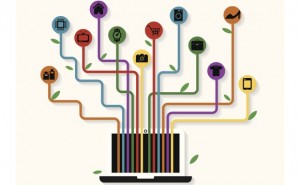March is out like a lion, and it’s time for our monthly Ecommerce Digest. This month, we wrote about removing your business blindfold with event tracking analytics. We produced this original infographic mapping the B2B buyer journey. We covered best practices for communicating value to free users. We talked to an expert for an insider’s view into information security, and we welcomed this month’s guest post about using embedded content to improve customer experience.
We’re not the only team publishing great content for the digital goods industry. Enjoy these selections from the past month.
B2B Ecommerce
Measuring Up: Benchmarking Your B2B Ecommerce Performance | Forrester
In their updated benchmark study, Forrester Research examined the state of B2B online sales, finding that the B2B online market is bullish. Online B2B sales enjoy healthy conversion rates, growing average order values and net-positive profitability, finding 47 percent of B2B companies believe profitability per online order is increasing. Even with these positive stats, B2B brings with it greater marketing and customer support costs.

Analyst Andy Hoar goes on to note, however, “It’s still early days for B2B eCommerce. Even those companies that have vaulted ahead of their competitors face significant challenges building the next-generation version of their business. B2B companies looking slightly over the horizon and positioning themselves successfully for 2016 and 2017 are focusing on:”
- Harnessing international growth opportunities
- Establishing critical metrics
- Understanding what tech infrastructure must be built-out over the next two to three years
- Shifting to an omnichannel approach
Predictive Analytics
Unified View Helps Execs Predict Customer Needs| eMarketer

A unified customer view allows companies to analyze the entire life of a customer’s relationship with their brand. Having all that information compiled into a holistic view is essential for companies that wish to jettison the traditional ‘transaction-centered’ perspective for a customer-centric one. With this perspective, a company puts customer experience at the center of their efforts.
But it’s more than just an attitude shift. Pooling customer data in one tool also allows for more complete customer analytics. Rather than the marketing team analyzing one slice of a customer, while the accounting team analyzes another slice, companies with a unified view can begin to see how their marketing efforts are impacting their revenue, or a how a feature release impacts customer support contacts.
With comprehensive data like this, a company can move from simply looking back at what customers have done to predicting what they will do. According to eMarketer, “More than six in 10 executives worldwide said that achieving a more complete view of the customer helped them more accurately predict customer needs and desires.”
IoT
Gartner: IoT Adoption Set for 50 Percent Growth in 2016 | CRN

If media buzz is any indication, then the Internet of Things (IoT) is big and getting bigger. Now Gartner has data to back up this trend. In their new report, they say that 64 percent of businesses they surveyed plan to implement an IoT strategy.
Chet Geschickter, research director at Gartner says, “2016 will be a very big year for IoT adoption. We are starting to see a wide range of IoT use cases across virtually all industries. But the big challenge now is demonstrating return on investment. Executives need to validate the contribution that IoT can make in order to justify large-scale rollouts.”
Subscriptions
Life, by Subscription | TechCrunch
Nic Milanovic over at TechCrunch provides a wide-angle view of the new subscription economy. Looking first at what is available via subscription, we see that far more than milk and newspapers can be had for a small, recurring fee. Milanovic looks at the technological and socioeconomic reasons for the prevalence of subscriptions today. Since the last economic downturn, most Americans have not rebuilt the savings they had before the collapse. The technology that made the sharing and gigging economy possible emerged just as these consumers were left with a dearth of liquid capital. Many younger adults, never having personally known the ownership economy, have fully embraced subscriptions as a way to taste the good life without owning it outright. As Milanovic says, “We may have to face the fact that it doesn’t make financial sense to own the things that we could instead simply subscribe to.”
This is the secret that digital companies have understood for years now. While from a consumer perspective, it may not make sense to buy something you can simply lease, from a business perspective it makes even less sense to make a one-time sale when you can earn recurring revenue. For customers, this means, “There is a financially shrewd Zen in not being tied to unmalleable objects. It frees people to spend money on pursuits other than that of saving to buy nice things.” So too, a subscription business model frees companies from the tyranny of the new sale, and allows them to focus on providing the best experience possible for subscribers — all with a stream of recurring revenue to support it.
Get help Navigating the Subscription Solutions Landscape
Global Compliance
Why a Tax Law Change in Australia Could Impact Online Revenues for US Online Retailers | Forrester

Beginning in July 2017, the Australian government will be expanding its Goods and Services Tax (GST) collection to purchases previously exempt under existing law. This March 10, 2016 blog post by Forrester analyst Lily Varon notes that not only is the value threshold of $1,000 being removed, but the tax will also be applied to new business categories — including digital goods.
“This GST change will also impact cross-border purchases of digital goods like software, gaming and media streaming. Merchants in these categories, like their physical goods counterparts, will have to calculate the impact of the increased GST and revise their pricing strategies and/or revenue forecasts accordingly.”
As online retail continues to grow, expect to see more jurisdictions applying their local sales taxes to digital goods.